ISS: Dragon COTS/CRS (Commercial Orbital Transportation Services/Cargo Resupply Service)
Non-EO
Human Spaceflight
Quick facts
Overview
| Mission type | Non-EO |
| Launch date | 08 Oct 2012 |
| End of life date | 26 Mar 2013 |
ISS Utilization: Dragon COTS/CRS (Commercial Orbital Transportation Services/Cargo Resupply Service)
The retirement plans of the Space Shuttle for 2010, announced by the Bush Administration in 2004, provided an entirely new situation for the ISS (International Space Station) program in the first decade of the new century. NASA was responsible for providing resupply and return cargo services to the ISS under international agreements. NASA originally intended to meet this requirement through Space Shuttle flights as well as through bartering with the international partners for transportation services on their vehicles. However, the announcement of the Bush Administration did not relieve NASA from its obligations for the ISS cargo transportation services. Hence, NASA and FAA (Federal Aviation Administration) developed a strategy to partner with private industry to assist in the development of private industry transportation services, and then to directly contract for resupply and return transportation services after these designs have proven reliable. 1)
The objective of the initiative was to procure critical resupply services for the ISS from the end of the Space Shuttle program to the end of the ISS Program (the period of performance for the then current ISS acquisition was seven years, from January 1, 2009 through December 31, 2015). The fundamental purpose of the CRS contract was that NASA would procure services and not hardware. In contrast to the Space Shuttle Program, NASA will not own or operate the launch vehicles and spacecraft that are used to deliver and return cargo. Since the U.S. Government does not own or operate these CRS launch vehicles or spacecraft, the launch and reentry of the cargo vehicles is treated as a commercial activity that must be licensed by the FAA to ensure that public safety is maintained (Ref. 1).
NASA established a two-phased approach to initiate the commercial space transportation industry’s ability to fulfill its needs through the Commercial Crew & Cargo Program Office (C3PO) at NASA/JSFC. 2)
1) Development and demonstration in the so-called COTS (Commercial Orbital Transportation Services) phase. Under COTS, NASA helps industry develop and demonstrate its own cargo space transportation capabilities. Industry leads and directs its own efforts with NASA providing technical and financial assistance. NASA is investing approximately $800M from 2006 through 2012 toward cargo space transportation flight demonstrations which are planned for completion in 2012. NASA payments are made only upon completion of progress milestones by its industry partners.
2) ISS Commercial Resupply Services (CRS): Phase 2 is a competitive procurement for cargo services to support the ISS. NASA awarded two contracts for transportation services in December 2008 to SpaceX and Orbital. The CRS contracts procured a total of 20 cargo transportation missions to the ISS through 2015.
The COTS program was announced on January 18, 2006. Two COTS commercial partners were selected: SpaceX (Space Exploration Technologies) and RpK (Rocketplane-Kistler). The agreement with RpK was later terminated after it failed to complete financial and technical milestones. A second competition was held to select a new funded commercial partner which resulted in selection of Orbital (Orbital Sciences Corporation) in February 2008.
Space Act Agreements: C3PO uses NASA’s Space Act authority to establish industry agreements and provide the legal flexibility necessary for the program. These agreements are known as SAAs (Space Act Agreements). The winners of the COTS competitions received funded SAAs. Companies with SAAs are not contractors; they are known as Commercial Partners (CPs).
The COTS commercial partners are responsible for the overall design, development, manufacturing, testing, and operation of their COTS system. In order to receive NASA financial assistance, the COTS partners must conduct the COTS demonstrations according to the terms and conditions in their SAAs and consistent with the COTS ISS Service Requirements Document (ISRD) and the ISS-to-COTS Interface Requirements Document (IRD).
Dragon COTS Spacecraft
Dragon is a free-flying, reusable spacecraft, developed by SpaceX (Space Exploration Technologies Inc.), a commercial company of Hawthorne, CA. Dragon is capable of hosting pressurized and unpressurized payloads under NASA's COTS program. Although designed to address cargo and crew requirements for the ISS, Dragon also provides an excellent platform for in-space technology demonstrations and scientific instrument testing. In 2012, SpaceX is manifesting fully commercial, non-ISS Dragon flights under the name of “DragonLab.” DragonLab represents an emergent capability for in-space experimentation. 3) 4)
The Dragon spacecraft is comprised of 3 main elements: the Nosecone, which protects the vessel and the docking adaptor during ascent; the Spacecraft, which houses the crew and/or pressurized cargo as well as the service section containing avionics, the RCS system, parachutes, and other support infrastructure; and the Trunk, which provides for the stowage of unpressurized cargo; it supports Dragon’s solar arrays and thermal radiators.
The subsystems include propulsion, power, thermal control, environmental control, avionics, communications, thermal protection, flight software, guidance, navigation & control, entry, descent & landing, and recovery.
Dragon capabilities | - Fully autonomous rendezvous and docking with manual override capability in crewed configuration |
Draco thrusters | - Eighteen Draco thrusters may be used for orbital maneuvering and attitude control (providing system redundancy) |
Thermal Protection System | - Dragon has the most powerful heat shield in the world; designed in cooperation with NASA, it is made of a material called PICA-X, a high performance variant on NASA’s original PICA (Phenolic Impregnated Carbon Ablator) |
Power | Two solar array wings on trunk (8 panels total) are used for power generation |
Avionics | Use of two fault tolerant avionics systems with extensive flight heritage |
Environmental Control System | - Provides a habitable cabin: Air circulation, fire detection and suppression, lights |
Reentry | - Designed for water landing under parachute for ocean recovery |
Transporting crew members | - To ensure a rapid transition from cargo to crew capability, the cargo and crew configurations of Dragon are almost identical, with the exception of the crew escape system, the life support system and onboard controls that allow the crew to take over control from the flight computer when needed. This focus on commonality minimizes the design effort and simplifies the human rating process, allowing systems critical to Dragon crew safety and space station safety to be fully tested on unmanned demonstration flights and cargo resupply missions |
Communications | - Communications between Dragon and the ISS are provided by CUCU (COTS UHF Communications Unit). CUCU was delivered to the Space Station on STS-129. |
Dragon endurance at ISS | 1 week to 2 years |
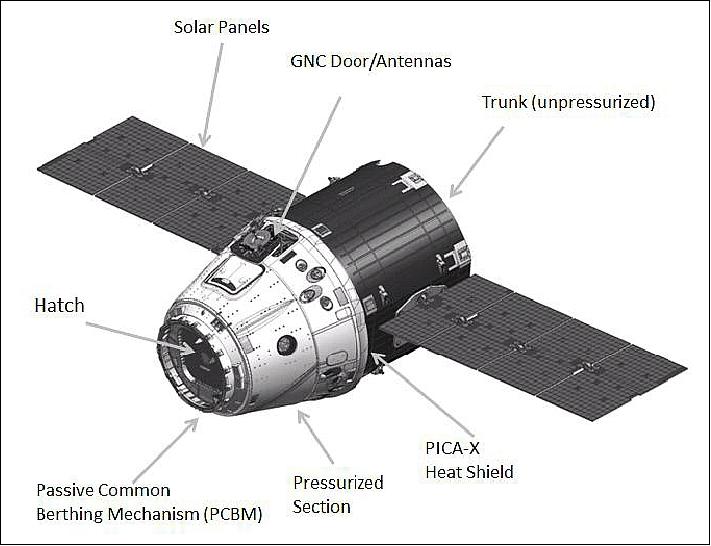

COTS Demonstration Flights of Dragon
COTS Demo Flight C1 Launch
Dragon C1 of SpaceX was launched from SLC-40 (Space Launch Complex-40) of Cape Canaveral on December 8, 2010 on a Falcon 9 rocket (marking the second flight of the Falcon 9 vehicle). The spacecraft conducted a series of demonstrations in orbit as part of NASA's COTS (Commercial Orbital Transportation Services ) program in support of the International Space Station. 5)
The primary mission objectives were to test the orbital maneuvering and the reentry capability of the Dragon capsule. In addition to being the first flight of an operational Dragon, there are many new systems and elements to test for the first time in space — structural integrity of the pressure vessel, precision firing of the 18 SpaceX Draco engines, telemetry, guidance, navigation and control systems, the PICA-X heat shield, and parachutes — to name a few. The mission also aimed to test fixes to the Falcon 9 rocket, particularly the unplanned roll of the first stage that occurred during Flight 1.
For the 4 hour test flight, this prototype Dragon capsule lacked the solar arrays and the docking mechanism of the operational Dragon-C capsule. Contrary to the operational missions, the unpressurized trunk stayed connected to the Falcon-9 v1.0 upper stage and only the capsule itself separated from the launch vehicle.
Orbit: Non-sun-synchronous orbit, low altitude of ~ 300 km apogee x 275 km perigee (due to the requirement of the primary payload), inclination = 34.5º, period = 88.1 minutes.
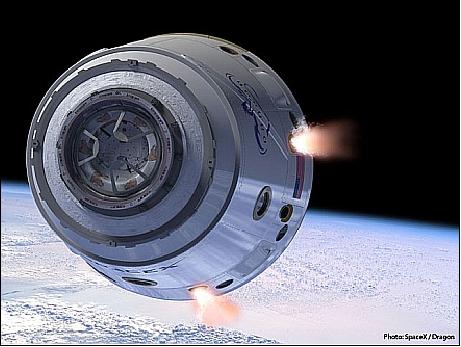
Secondary payloads deployed from Dragon C1 on P-POD:
• SMDC-ONE (Space and Missile Defense Command-Operational Nanosatellite Effect), a nanosatellite of ~ 4.5 kg of the US Army. 6) 7)
• Caerus/Mayflower: A 1U CubeSat technology mission of USC (University of Southern California)+ 2U CubeSat of Northrop Grumman and Novaworks.
• QbX-1 (CubeSat Experiment-1): 3U CubeSat Colony I bus of Pumpkin Inc., provided by NRL (Naval Research Laboratory) for NRO (National Reconnaissance Office)
• QbX-2 (CubeSat Experiment-2): 3U CubeSat, Colony I bus of Pumpkin Inc., provided by NRL (Naval Research Laboratory) for NRO, both CubeSats are technology missions. 8)
The low orbital altitude of 300 km permitted the secondary payloads to remain in orbit for only ~30 days.
After the planned two orbits with a flight time of 3 hours and 20 minutes, the craft was manually deorbited. The spacecraft splashed down in the Pacific Ocean off the west coast of Mexico (~800 km west of Baja California), after all three parachutes successfully deployed. The recovery craft arrived to retrieve the spacecraft within 20 minutes of splashdown.
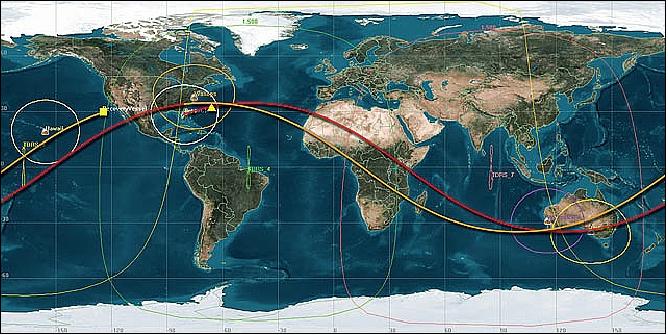
Legend to Figure 4: The yellow triangle over the Atlantic ocean marks Dragon’s initial separation from Falcon 9, and the yellow square off the Western coast of the United States marks the location where Dragon landed.
The success of the mission allowed SpaceX to advance its vehicle testing plan. With the two back-to-back "near-perfect" Falcon 9 launches (including Falcon 9 Flight 1 in June 2010) and the successful orbital operation, reentry and parachute landing of its first Dragon capsule,SpaceX asked NASA to combine objectives laid out for the remaining two COTS missions ... and permit a berthing at the [space station] during its next flight, which was completed successfully in 2012.
COTS Demo Flight C2/C3
The demonstration flight, called COTS 2/3 (Commercial Orbital Transportation Services-2/3), was the premiere test flight in NASA’s new strategy to resupply the ISS with privately developed rockets and cargo carriers under the COTS initiative. The launch of the SpaceX Dragon capsule to the ISS started a new era in NASA's ISS program. 10) 11)
Mission objectives: While the Dragon spacecraft’s attempt to visit the ISS represents a historic first, the act of berthing itself represents only one of many significant challenges involved in this demonstration mission. Successfully attaching to the space station is an important goal, but it is only one measure of success. 12)
During this flight, SpaceX must complete milestones for two separate missions – COTS 2 and COTS 3. SpaceX and NASA agreed on the following objectives for those two missions:
• Complete Licenses and Certifications
• Rocket Launch and Spacecraft Inserted into Orbit
• On-Orbit Operations
• De-orbit Burn & Separation
• Controlled Entry, Descent, and Landing
• Recovery.
COTS 3 mission objectives:
• On-Orbit Operations — Approach
• ISS — Attached Operations
• On-Orbit Operations — Departure
• Recovery (Ref. 12).
Demo C2/3 Launch
The Dragon C2/3 spacecraft was launched successfully on May 22, 2012 (7:44 UTC) with the SpaceX Falcon-9 vehicle from the Cape Canaveral Air Force Station, Florida. 13)
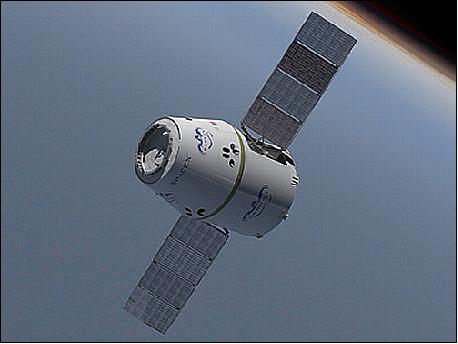
• During the flight, SpaceX's Dragon capsule was commanded to conduct a series of check-out procedures to test and prove its systems, including rendezvous and berthing with the ISS.
• The primary objectives for the flight demonstration included a flyby of the ISS at a distance of approximately 2.5 km to validate the operation of sensors and flight systems necessary for a safe rendezvous and approach. The spacecraft also demonstrated the ability to abort the rendezvous. - At this point, the COTS-2 objectives were completed — and immediately followed by the COTS-3 goals (involving the vehicle approach and attachment operations to the station). 14)
• After these capabilities were successfully proven, the Dragon spacecraft was cleared to berth with the ISS. Dragon was commanded by the SpaceX flight control team based in Hawthorne, CA.
• On May 25, 2012, Dragon was berthed at the ISS, after being captured by the astronaut crew using the station’s robotic arm (Canadarm-2) and maneuvered it carefully into the Harmony module docking port.
• The Dragon capsule delivered 460 kg of supplies to the station, which included non-critical experiments, food, clothing and technology.
• SSEP (Student Spaceflight Experiments Program): Since its inception in June 2010, the SSEP has capitalized on NASA's science and exploration missions to encourage students to pursue a STEM-centric school curriculum. The first two SSEP payloads flew in 2011 aboard space shuttles Endeavour and Atlantis on the STS-134 and STS-135 missions, respectively. A third round of experiments now has made its way to the International Space Station. 15)
A suite of 15 SSEP experiments were aboard the SpaceX Dragon capsule when it docked with the station on May 25, 2012 and will be the first to be conducted in orbit by space station astronauts.
Known collectively as Aquarius, the experiments will assess the effects of microgravity on physical, chemical and biological systems. The students have been immersed in every facet of research, from definition of the investigation to experiment design, proposal writing and a formal NASA proposal review for selection of flight experiments.
• On May 31, 2012, Dragon was detached from the Harmony module, after being loaded with 620 kg of hardware and cargo no longer needed aboard the station.
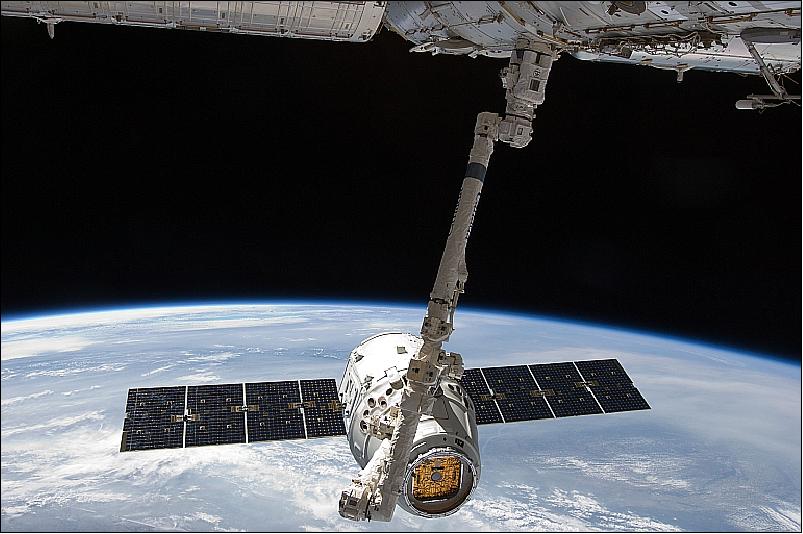
• The Dragon capsule, featuring a heat shield, deorbited ~ 4 hours after leaving the station, taking about 30 minutes to reenter Earth's atmosphere. It landed on a parachute assembly in the Pacific Ocean about 500 km west of Baja California. 16)
The flight of the SpaceX Dragon, the first private spaceship ever to connect to the International Space Station, was a major achievement for the company and for NASA, demonstrating its ability to safely deliver cargo to the station. Previously only four governments — the United States, Russia, Japan and the European Space Agency — had achieved this challenging technical feat. 17)
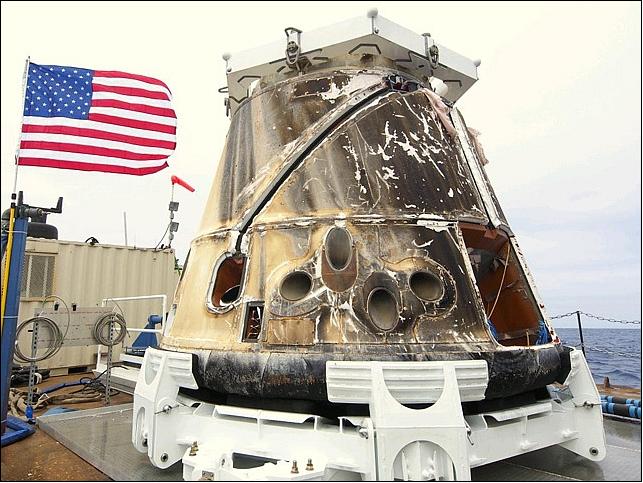
CRS-1(Cargo Resupply Services-1) Mission Launch
On October 8, 2012 (UTC) Dragon launched atop a Falcon 9 rocket from the Cape Canaveral Air Force Station in Florida, beginning NASA's first contracted cargo delivery flight, designated SpaceX CRS-1(Cargo Resupply Services-1) mission, to the ISS (International Space Station). 18)
• On Oct. 10, 2012, Dragon was securely in the grasp of Canadarm2, ground controllers remotely operated the arm to guide the capsule to the Earth-facing side of the Harmony module. Dragon is scheduled to spend 18 days attached to the station. It will be loaded with ~720 kg of cargo for return to Earth. 19) 20)
• The OG2-1 (OrbComm Second Generation-1) prototype satellite, flying as a secondary payload on this mission, was separated from the Falcon 9 launch vehicle at approximately 9:00 pm EST. However, due to an anomaly on one of the Falcon 9's first stage engines, the rocket did not comply with a pre-planned ISS safety gate to allow it to execute the second burn. For this reason, the OG2-1 prototype satellite was deployed into an orbit that was lower than intended. ORBComm and Sierra Nevada Corporation engineers have been in contact with the satellite and are working to determine if and the extent to which the orbit can be raised to an operational orbit using the satellite's on-board propulsion system. 21)
Although OG2-1 reentered the atmosphere on October 10, 2012, the engineering teams made significant strides in testing various hardware components. After telemetry and command capability was established, several critical system verifications were performed. 22)
• On Oct. 28, 2012, the Dragon capsule of SpaceX left the ISS and splashed down in the Pacific Ocean west of Baja California, Mexico. The splashdown successfully ended the first NASA contracted cargo delivery flight to resupply the ISS. The capsule delivered 450 kg of cargo to the space station and is taking home 758 kg of supplies, hardware and scientific tests and results. The ability to return frozen samples is a first for this flight and will be tremendously beneficial to the station's research community. 23)
CRS-2 (Cargo Resupply Services-2) Mission Launch
On March 1, 2013, SpaceX launched its second CRS mission for NASA to the ISS (International Space Station). The Dragon spacecraft was launched on the Falcon 9 rocket from the Cape Canaveral Air Force Station in Florida, carrying ~575 kg of supplies, including critical materials to support the 160 investigations – 50 of which are new – planned for the station’s Expedition 34 crew. 24) 25)
• After Dragon separated from Falcon 9's second stage approximately nine minutes after launch and achieved orbit, a malfunction occurred with some of Dragon's thruster pods. The Dragon lost three of its four thruster pods. Solar array deployment was delayed while SpaceX engineers worked to purge blocked valves and get the pods back online. Ninety minutes after launch, Dragon's solar arrays were deployed. A few hours later, all four thruster pods were online and attitude control was regained. Following a series of tests to ensure the spacecraft could safely approach the space station, Dragon was approved to approach the orbiting laboratory on March 3, one day after its originally planned arrival. 26)
• The Dragon spacecraft was berthed to the ISS on March 3, 2013 using the station's robotic arm (Canadarm 2). The capture came one day, 19 hours and 22 minutes after the mission's launch. Following its capture, the spacecraft was installed onto the Earth-facing port of the Harmony module through ground commands issued by mission control at NASA/JSC in Houston. 27)
• After Dragon’s mission at the station is completed, the crew will use Canadarm2 to detach Dragon from Harmony on March 25, 2013 and release it for a parachute-assisted splashdown in the Pacific Ocean about 500 km west of the coast of Baja California. Dragon is the only cargo craft capable of returning a significant amount of supplies from the ISS to Earth, including experiments.
• On March 26, 2013, the Dragon spacecraft of SpaceX completed the company's second cargo flight to the ISS with a splashdown in the Pacific Ocean off the coast of Baja California, Mexico. Dragon returned returned ~ 1210 kg of science samples, equipment and education activities. Among the returned investigations was the CSLM-3 (Coarsening in Solid-Liquid Mixtures) experiment, which also launched to space aboard this Dragon. CLSM-3 studies how crystals known as dendrites form as a metal alloy becomes solid. The research could help engineers develop stronger materials for use in automobile, aircraft and spacecraft parts. Dragon also returned several human research samples that will help scientists continue to examine how the human body reacts to long-term spaceflight. 28)
SpaceX is one of two companies to build and test new cargo spacecraft under NASA's Commercial Orbital Transportation Services (COTS) program. Orbital Sciences Corp. of Dulles, VA, is the other company participating in COTS. A demonstration flight of Orbital's Antares rocket and Cygnus spacecraft to the station is planned for later this year.
NASA initiatives such as COTS and the agency's Commercial Crew Program are helping develop a robust U.S. commercial space transportation industry with the goal of achieving safe, reliable and cost-effective transportation to and from the space station and low Earth orbit. In addition to cargo flights, NASA's commercial space partners are making progress toward a launch of astronauts from U.S. soil in the next few years.
References
1) “NASA and Federal Aviation Administration Joint Program Management Plan (PMP) for the Commercial Resupply Services Contracts,” April 2011, URL: http://www.faa.gov/.../Joint%20Program%20Management%20Plan%20for%20FAA-NASA%20Partnership%20on%20CRS-Signed%20and%20Final%20April%202011.pdf
2) “NASA Commercial Orbital Transportation Services,” NASA, March 2, 2012, URL: http://www.nasa.gov/offices/c3po/about/c3po.html
3) “DragonLab Data sheet,” SpaceX, URL: http://www.spacex.com/dragon.php
4) Alan Lindenmoyer, “Commercial Orbital Transportation Services (COTS) Status,” NASA Advisory Council Commercial Space Committee, MSFC, AL , USA, February 23, 2012, URL: http://www.nasa.gov/pdf/627984main_4-Status%20of%20COTS_508.pdf
5) “COTS Flight 1 Press Kit,” SpaceX, 2010, URL: http://www.spacex.com/downloads/cots1-20101206.pdf
6) John Cummings, “Army Nanosatellite On First Flight,” Space Daily, Dec. 10, 2010, URL: http://www.spacedaily.com/reports/Army_Nanosatellite_On_First_Flight_999.html
7) John Cummings, “Army nanosatellite completes first flight,” Jan. 14, 2011, URL: http://www.army.mil/-news/2011/01/14/50426-army-nanosatellite-completes-first-flight/
8) “NRL launches nano-satellite experimental platforms,” Phys.org, Dec. 17, 2010, URL: http://phys.org/news/2010-12-nrl-nano-satellite-experimental-platforms.html
9) “SpaceX email Newsletter,” Dec. 15, 2010, URL: http://www.spacex.com/updates_archive.php?page=2010
10) “SpaceX Demonstration Mission,” URL: http://www.nasa.gov/pdf/641019main_pk_overview.pdf
11) Kathryn Lueders, “Proposed CombinedC2/C3 Mission Assessment,” NASA, Max 3, 2011, URL: http://www.nasa.gov/pdf/553720main_Lueders%20C2C3%20Combine%20Assessment%205-2011.pdf
12) “SpaceX COTS 2 Mission Press Kit,” NASA, URL: http://www.nasa.gov/pdf/649910main_cots2_presskit_051412.pdf
13) Patrick Blau, “Dragon C2/3 Mission Coverage,” Spaceflight 101, May 22, 2012, URL: http://www.spaceflight101.com/dragon-c2-mission-updates.html
14) Kay Grinter, “SpaceX Demonstration Mission,” NASA, URL: http://www.nasa.gov/pdf/641018main_pk_objectives.pdf
15) “Students' Microgravity Experiments Find Way to Station,” NASA, June 1, 2012, URL: http://www.nasa.gov/exploration/commercial/cargo/spacex_studentxperiments.html
16) Steven Siceloff, “Dragon Splashdown Marks End of Landmark Flight,” NASA, May 31, 2012, URL: http://www.nasa.gov/exploration/commercial/cargo/spacexmissionoverview.html
17) “NASA COTS - DEMO ¿,” SpaceX, June 2012, URL: http://www.spacex.com/F9-003.php
18) “SpaceX CRS-1 Mission,” NASA Press Kit/October 2012, URL: http://www.nasa.gov/pdf/694074main_SpaceXCRS-1PressKit.pdf
19) “Station Welcomes First Commercial Resupply Mission,” NASA, Oct. 10, 2012, URL: http://www.nasa.gov/mission_pages/station/expeditions/expedition33/dragon_arrives.html
20) Trent J. Perrotto, Josh Byerly, “SpaceX's Dragon Carrying NASA Cargo Resupplies Space Station,” NASA, Oct. 10, 2012, URL: http://www.nasa.gov/home/hqnews/2012/oct/HQ_12-357_SpaceX_CRS-1_Berthing.html
21) “ORBCOMM Launches Prototype Satellite - OG2 satellite's insertion orbit lower than planned,” Space Ref, Oct. 8, 2012, URL: http://spaceref.com/news/viewpr.html?pid=38833
22) “OG2 Prototype Hardware Functionality Verified Prior to Deorbit,” Space Daily, Oct. 15, 2012, URL: http://www.spacedaily.com/.../OG2_Prototype_Hardware_Functionality_Verified_Prior_to_Deorbit
23) Trent J. Perrotto, Josh Byerly, “SpaceX Dragon Returns from Space Station with NASA Cargo ,” NASA, Oct. 28, 2012, URL: http://www.nasa.gov/home/hqnews/2012/oct/HQ_12-381_SpaceX_CRS-1_Splashdown.html
24) “SpaceX CRS-2 Mission Press Kit,” SpaceX, NASA, URL: http://www.spacex.com/downloads/crs2-press-kit.pdf
25) “SpaceX 2 Cargo Manifest,” NASA, URL: http://www.nasa.gov/pdf/729030main_spacex_2_cargo_manifest.pdf
26) Patrick Blau, “Dragon SpX-2 - External Cargo Operations completed by Canadarm2,” Spaceflight 101, March 6, 2013, URL: http://www.spaceflight101.com/dragon-crs-2-spx-2-mission-updates.html
27) “Dragon Arrives With Treasure Trove of Science,” NASA, March 3, 2013, URL: http://www.nasa.gov/mission_pages/station/expeditions/expedition34/dragon_arrives.html
28) Trent J. Perotto, Josh Byerly, “SpaceX Dragon Spacecraft Returns Critical NASA Science to Earth,” NASA Release: 13-085, March 26, 2013, URL: http://www.nasa.gov/home/hqnews/2013/mar/HQ_13-085_SpaceX_Splashdown.html
The information compiled and edited in this article was provided by Herbert J. Kramer from his documentation of: ”Observation of the Earth and Its Environment: Survey of Missions and Sensors” (Springer Verlag) as well as many other sources after the publication of the 4th edition in 2002. - Comments and corrections to this article are always welcome for further updates (eoportal@symbios.space).